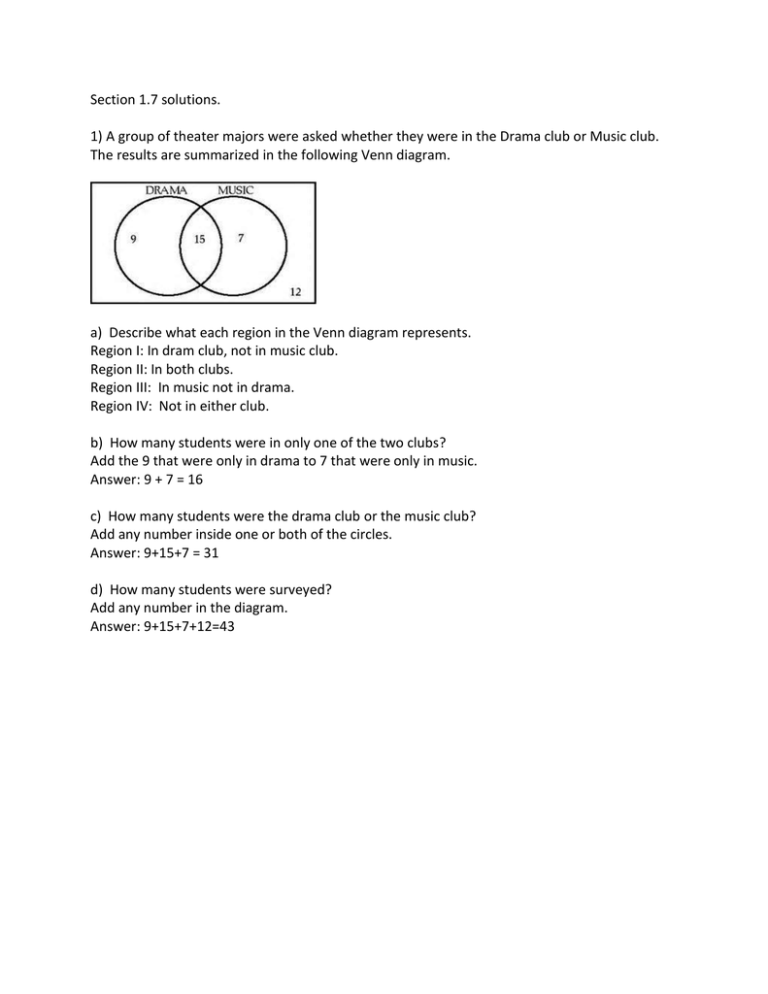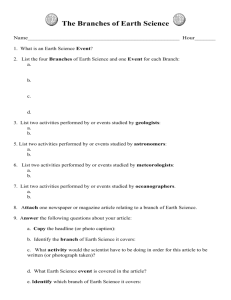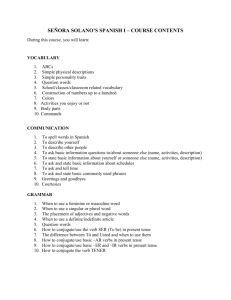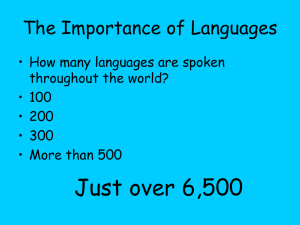section 1.7 solutons
advertisement

Section 1.7 solutions. 1) A group of theater majors were asked whether they were in the Drama club or Music club. The results are summarized in the following Venn diagram. a) Describe what each region in the Venn diagram represents. Region I: In dram club, not in music club. Region II: In both clubs. Region III: In music not in drama. Region IV: Not in either club. b) How many students were in only one of the two clubs? Add the 9 that were only in drama to 7 that were only in music. Answer: 9 + 7 = 16 c) How many students were the drama club or the music club? Add any number inside one or both of the circles. Answer: 9+15+7 = 31 d) How many students were surveyed? Add any number in the diagram. Answer: 9+15+7+12=43 3) A group of coffee drinkers were asked what the added to their coffee. The results are summarized in the following Venn diagram. a) Describe what each region in the Venn diagram represents. Region I: Add cream, do not add sugar Region II: Add both cream and sugar Region III: Add sugar, do not add cream Region IV: Don’t use either b) How many coffee drinkers didn’t use either cream or sugar? Answer: 0, this would be a number outside the circles. c) How many coffee drinkers used cream or sugar? I need to add each number inside the circles. Answer: 16+20+35=71 d) How many coffee drinkers only used one of the two? Add the 16 with cream only and the 35 with sugar only. Answer: 16 +35 = 51 5) The International School offers French, Spanish and Japanese classes. A group of students was asked which languages they had studied. a) Describe what each region in the Venn diagram represents. Region I: studied French, did not study Spanish, did not study Japanese Region II: studied both French and Spanish, did not study Japanese Region III: studied Spanish, did not study French, did not study Japanese Region IV: studied French and Japanese, did not study Spanish Region V: studied all three Region VI: studied Spanish and Japanese, did not study French Region VII: studied Japanese, did not study French, did not study Japanese Region VIII: did not study any of the three b) How many students had studied exactly one of the three? Spanish only + French only + Japanese only: Answer: 32 + 23 + 9 = 64 c) How many students studied Spanish or French? Add any number in the Spanish or French circles. 23+5+4+20+7+32 = 91 d) How many students studied Spanish or French, but not Japanese? 23 French only + 32 Spanish only + 20 French and Spanish, not Japanese Answer: 75 7) A veterinarian surveys 26 of his patrons. He discovers that: 14 have dogs 10 have cats 8 have both cats and dogs. a) Create a Venn diagram to model the information. Region II: Given number 8 Region I: 14 – 8 = 6 Region III: 10 – 8 = 2 Region IV: 26 – (6+8+2) = 26 – 16 = 10 b) How many patrons had dogs or cats? Any number inside a circle. Answer: 6+8+2 16 c) How many patrons had dogs but not cats? Answer: 6 d) How many patrons didn’t have either? Answer: 10 9) In a survey of 20 students in a class: 10 were liked pineapple juice 15 were liked of orange juice 7 liked to have both a) Create a Venn diagram to model the information. Region II: 7 given in the problem Region I: 10 – 7 = 3 Region III: 15 – 7 = 8 Region IV: 20 – (3+7+8) = 20 – 18 = 2 b) How many people like pineapple juice or orange juice? Add any number inside circle. Answer: 18 c) How many like orange juice but not pineapple juice? Answer: 8 d) How many patrons didn’t like either? Answer: 2 11) A gym is thinking about adding more cardio equipment for its members. It is considering two types of equipment, treadmills (T) and Stair Masters (S). The gym surveyed a sample of the members and asked which equipment they used in the previous month. Of 150 gym members surveyed it was found that… 102 used the treadmills 71 used the Stair Masters 40 used both types. a) Create a Venn diagram to summarize the information. Region II: 40 given in the problem Region I: 102 – 40 = 62 Region III: 71 – 40 = 31 Region IV: 150 – (62+40+31) = 150 - 133 = 17 b) How many did not use either the treadmill or the Stair Master? Answer: 17 c) How many used the treadmill but not the Stair Master? Answer: 62 d) How many used the Stair Master but not the treadmill? Answer: 31 e) How many used at least one of the two? Any number inside a circle. Answer: 62 + 40 + 31 = 133 13) Out of 40 students: 14 are taking Chemistry 29 are taking English 5 are taking both a) Create a Venn diagram to model the information. Region II: 5 taking both Region I: 29 – 5 = 24 Region II: 14 – 5 = 9 b) How many students are taking Chemistry, but not English? Answer: 9 c) How many are taking Chemistry or English? Add any number inside a circle. Answer: 24 + 5 + 9 = 38 d) How many are taking exactly one of the two classes? Answer: 24 + 9 = 33 15) 105 adults were asked whether they had studied French, Spanish or Japanese in school. Here are the results of the survey: 5 are taking all three 9 have studied both Japanese and French 11 have studied both Japanese and Spanish 24 have studied both Spanish and French 52 have studied French 63 have studied Spanish 25 have studied Japanese a) Create a Venn diagram to model the information. Region V: 5 (given in problem) Region IV: 9 – 5 = 4 Region II: 24 – 5 = 19 Region VI: 11 – 5 = 6 Region I: 52 – (4+5+19) = 52 – 28 = 24 Region III: 63 – (19+5+6) = 63 – 30 = 33 Region VII: 25 – (4+5+6) = 25 – 15 = 10 Region VIII: 105 – (24+19+33+4+5+6+10) = 105 -101 = 4 b) How many have studied Spanish but not French? Answer: 33 + 6 = 39 c) How many have studied Japanese but not French? Answer: 10+6 = 16 d) How many have studied both French and Spanish? Answer: 19 + 5 = 24 e) How many have studied French or Spanish? Answer: 24+4+5+19+6+33=91 f) How many have studied both French and Spanish but not Japanese? 19 17) 33 U.S. cities with large populations were surveyed to determine whether they had a professional baseball team, a professional football team, or a professional basketball team. The following information was determined. 5 had all three teams 11 had baseball and football 7 had baseball and basketball 9 had football and basketball 16 had baseball 17 had football 15 had basketball a) Create a Venn diagram to model the information. Region V: 5 that have all three Region IV: 7 – 5 = 2 Region II: 11 – 5 = 6 Region VI: 9 – 5 = 4 Region I: 16 – (2+5+6) = 16 – 13 = 3 Region III: 17 – (2+5+4) = 17 – 11 = 6 Region VII: 15 – (2+5+4) = 15 – 11 = 4 Region VIII: 33 – (3+6+2+2+5+4+4) = 33 – 26 = 7 b) c) d) e) How many cities had only football? Answer: 2 How many cities had baseball or football? Answer: 3+6+2+2+5+4 = 22 How many cities had both baseball and football but not basketball? Answer: 6 How many had exactly two teams? Answer: 2+6+4 = 12 19) In a survey of 75 people, Sam found that: 9 liked all the three products 24 people liked both products A and B 20 people liked products C and A 18 people liked product B and C 38 people liked product A 36 liked product B 39 liked product C a) Create a Venn diagram to model the information. Region V: 9 that liked all three Region IV: 20 – 9 = 11 Region II: 24 – 9 = 15 Region VI: 18 – 9 = 9 Region I: 38 – (11+9+15) = 38 – 35 = 3 Region III: 36 – (15+9+9) = 36 – 33 = 3 Region VII: 39 – (11+9+9) = 39 – 29 = 10 Region VIII: 75 – (3+15+3+11+9+9+10) = 75 – 60 = 15 b) How many liked product A or B? Answer: 3+11+9+15+9+3 = 50 c) How many liked product both A and B, but not C? Answer: 15 d) How many didn’t like any of the three products? Answer: 15 21) 100 students were asked which fast food restaurant they have been to this year. The results of the survey were as follows: 5 have been to all three 20 have been to both McDonald’s and Taco Bell 25 have been to both Subway and McDonald’s 15 have been to both Taco Bell and Subway 50 have been to McDonald’s 40 have been to Taco Bell 45 have been to Subway a) Create a Venn diagram to model the information. Region V: 5 been to all three Region IV: 25 – 5 = 20 Region II: 20 – 5 = 15 Region VI: 15 – 5 = 10 Region I: 50 – (20+5+15) = 50 – 40 = 10 Region III: 40 – (15+5+10) = 40 – 30 = 10 Region VII: 45 – (20+5+10) = 45 – 35 = 10 Region VIII: 100 – (10+15+10+20+5+10+10) = 100 – 80 = 20 b) c) d) e) How many did not go to any of the three? Answer: 20 How many have been to McDonald’s or Taco Bell? Answer: 10+20+5+15+10+10= 70 How many have been to McDonald’s or Taco Bell, but not Subway? Answer: 10+15+10= 35 How many have been to exactly two of the three? Answer: 20 + 15 + 10 = 45



